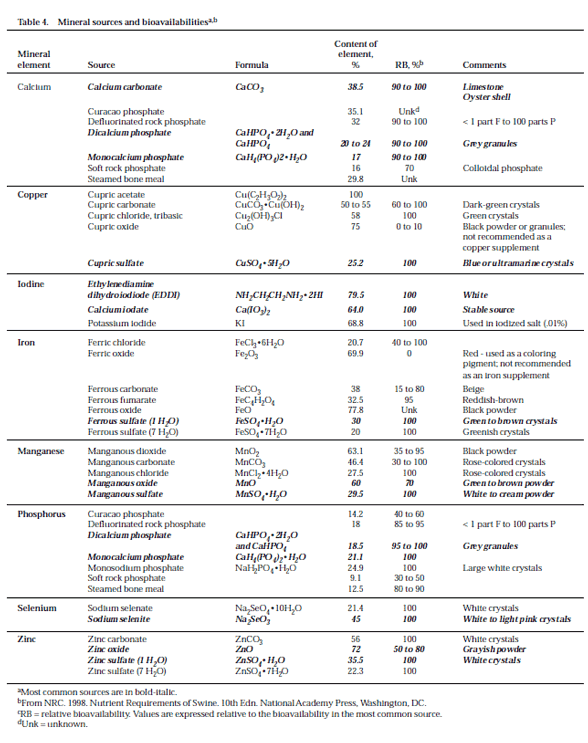Swine Nutrition Guide: Nutrient Sources - Minerals
Minerals -- Minerals serve many important functions in pig nutrition. These range from structural functions in bone to a wide variety of chemical reactions essential for maintenance, growth, reproduction and lactation. Pigs require at least 13 minerals. Of these calcium, chloride, copper, iodine, iron, manganese, phosphorus, selenium, sodium and zinc should routinely be added to the diet. Practical corn-or milo-soybean meal based diets contain sufficient levels of magnesium, potassium and sulfur.
What are the major sources of minerals for swine?
Major sources of the minerals commonly added to swine diets are listed in Table 4. In addition, the relative bioavailability of minerals from several sources are listed in the table to ensure precise diet formulation. Base decisions on which source of trace mineral to use primarily on price per unit of available element. The use of selenium in animal feeds is regulated by the FDA.
What is meant by available phosphorus?
Like amino acids, a certain proportion of the phosphorus in a feedstuff cannot be used by pigs. Most of the phosphorus in corn and other feed grains, soybean meal, oilseed meals and other byproducts of seed origin occurs as the organic complex phytate. Phosphorus in this form is poorly available to pigs because they lack the enzyme phytase, which releases the phosphorus. Research indicates there are large differences in phosphorus availability among feedstuffs. In the most precise type of diet formulation, adjustments are made for these differences. That is, diets are formulated on an available rather than total phosphorus basis.
When diets contain primarily corn or milo and soybean meal it is appropriate to formulate them on a total phosphorus basis. However, when nontraditional or byproduct ingredients are used in pig feed, formulate the diets on an available phosphorus basis. See Tables 11, 12, 13, 14 and 15 for available and total phosphorus recommendations for complete feeds.
Table 29 contains the available phosphorus content of several ingredients. Supplementing swine diets with phytase has been effective in improving the availability of phosphorus in corn and soybean meal. This means less inorganic phosphorus (e.g., from dicalcium phosphate) is needed in the diet, resulting in less phosphorus in the manure. While most manure management plans are based on nitrogen, there is increasing interest in basing them on phosphorus.
This is in an effort to decrease phosphorus buildup in the soil, and to reduce the potential for phosphorus runoff into lakes and rivers. However, land requirements for a phosphorus- based swine manure management plan are at least twice that required for a nitrogen-based plan. Therefore, depending on the cost of manure application and whether the manure management plan is based on nitrogen or phosphorus, the use of phytase in swine diets may be economical.
The development of low phytate phosphorus varieties of corn is another method producers can use to reduce phosphorus excretion and use of inorganic phosphorus. Preliminary data indicate that the use of these varieties can reduce phosphorus excretion and the use of inorganic phosphorus and may improve the digestibility of other nutrients. However, factors such as yield drag, cost of raising the crop, etc, must be considered when deciding whether to use low phytate phosphorus corn.

What are chelated or proteinated trace minerals?
Trace minerals generally are added to swine diets as inorganic salts, such as copper sulfate, iron sulfate, zinc oxide, etc. Chelated forms of some trace minerals have become available. Trace minerals are bound to a compound such as a protein or individual amino acid to form a chelate (e.g. zinc-methionine and iron-lysine).
The chelate is designed to enhance the absorption of the trace mineral from the small intestine. Research in pigs, however, has demonstrated that the bioavailability of the minerals in chelated forms is not always greater and is sometimes lower than the bioavailability of elements in inorganic salts. Usually the inorganic forms of trace minerals are most economical.
How important are dietary electrolytes?
Electrolytes (minerals) are essential to maintaining water balance in pigs. Electrolyte balance is particularly important for starting pigs, because they are more susceptible to diarrhea, which can cause severe dehydration.
The major elements involved in electrolyte balance are sodium, chloride, potassium, magnesium and calcium, but sodium, chloride and potassium predominate. We do not recommend including electrolytes in swine diets at levels exceeding those shown in Tables 11, 12, 13, 14, 15 and 16 even in times of stress, such as those associated with weaning and feeder pig sales and transfers.
This article hasn't been commented yet.


Write a comment
* = required field